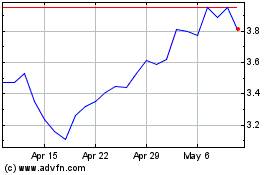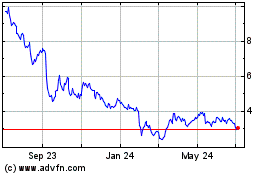“Recession Shock” Hits the Oil Market; Are Future Shocks and Oil Market Volatility Inevitable?: New CERA Analysis
December 19 2008 - 7:30AM
Business Wire
The past 12 months have seen volatility in oil prices on an
unprecedented scale. A new special report, Recession Shock: The
Impact of the Economic and Financial Crisis on the Oil Market,
released today by Cambridge Energy Research Associates (CERA) as
part of the London Energy Meeting, explores these issues,
including: What is driving this extraordinary volatility; the
effects on future demand and supply, and the effects on investment
and energy security; how the financial crisis and economic downturn
is exacerbating the volatility of oil prices, and the possible
risks and unanticipated consequences. The London Energy Meeting is
being convened by British Prime Minister Gordon Brown bringing
energy ministers and other leaders from around the world together
for a summit on the global economy and oil markets. It follows a
similar meeting convened in Jeddah, in Saudi Arabia, in June 2008.
�Spare capacity will increase significantly in the next few years
due to falling oil demand and as supply materializes from
investments already under way,� said Daniel Yergin, CERA chairman
and IHS executive vice president, who is presenting the results of
the study to the assembled energy ministers at the London meeting.
�As low as one million barrels per day in 2005 and 2.4 million
barrels per day in 2008, it could reach seven to eight million
barrels per day in 2010 to 2012. �However, in the medium term, low
prices and financial constraints will hinder new investment,�
Yergin added. �Consequently, as the economy picks up, spare
capacity will start to erode and the oil market could begin to
tighten again, in the reference case, by 2013 taking the world into
a new cycle.� Oil Price Today Barometer of Weaker Global Economy
�Another era of strong global economic growth could also accelerate
tightness,� Yergin added. �Conversely, if prices are supported at
too high a level, long-term spare capacity will grow to levels that
could result in a period of prolonged low oil prices.� Among other
key factors that the report notes is the potential impact from
increased emphasis by governments on greater energy efficiency and
alternative fuels. Commissioned by the United Kingdom Department of
Energy and Climate Change and the Ministry of Petroleum and Mineral
Resources of Saudi Arabia, �Recession Shock� provides context and a
framework for understanding the unprecedented rise in oil prices
since 2001. It explains why economic growth was not derailed sooner
and why prices have collapsed in the past few months. It also
presents an illustrative outlook for the world economy and oil
market, and examines the psychology of the oil market that reached
its apogee in the summer of 2008 � triggered by events that began
half a decade earlier. �The oil price was driven to its
oxygen-short heights last summer by the �demand shock� that came
from five years of strong economic growth, and was fueled further
by geopolitics, oil field costs, financial markets and trading, and
psychology,� said Yergin, who received the Pulitzer Prize for his
book The Prize: the Epic Quest for Oil, Money, and Power. �But
today, the oil market is being shaken mightily by a recession shock
� and not just a recession shock for oil, but for all energy
markets and industries, both conventional and alternatives and
renewables,� he continued. �The oil price today is the barometer
measuring a progressively weaker global economy.� U.S. Oil Demand
in �08 Expected to be 1 mbd Less than �07 The report states that
gasoline/petrol consumption in the U.S. hit �peak demand� in 2007
and was beginning to decline before the economic crisis broke, but
�the demand responses were discounted or ignored� in the financial
markets where oil is traded. Yet demand was responding to higher
prices, except in those parts of the world where retail fuel prices
are controlled or subsidized. Total U.S. oil demand in 2008 is
expected to be at least one million barrels per day (mbd) less than
in 2007. Other industrial countries tell similar stories. The last
time demand dropped this much was in the deep recession of 1981. On
a global basis, estimates for demand growth from some analysts at
the beginning of 2008 were as high as 2.1 mbd of growth, but have
fallen dramatically. CERA�s current estimate for 2008 is a decline
of almost 300,000 barrels per day and a decline of another 660,000
barrels per day in 2009. The report goes on to say that
notwithstanding the weakness in oil demand and prices, oil supply
capacity � the difference between total liquids production capacity
and actual output � will expand as new supplies, already under
development, come to market. That surplus in spare capacity will be
a �defining factor� for the oil market. Oil Price Fall �de facto
Tax Cut� �The fall in oil prices is a great bounty to hard-pressed
consumers midst a global recession, especially to those in which
the tax component of retail prices is relatively small,� Yergin
said. �If one compares the average U.S. gasoline price in July 2008
($4.14 a gallon) with October 2008 ($2.26) on an annualized basis,
the savings to American consumers are $282 billion (�220 billion,
�180 billion). The fall in oil prices is a sort of de facto tax cut
� an automatic stimulus package that does not need to be paid for
from consumer nation public funds.� The report asks whether the
current collapse could be �sowing the seeds of the next oil price
spike?� The report concludes that occasional shocks to the global
economy and volatility in the oil market will be inevitable in the
future, but the extremes from peak to trough of price movements can
be moderated. Volatility may be an unintended side effect of
periods of �consensus about expected future oil prices� and such
periods are characteristic of the industry worldwide. Greater
transparency of market information and data about supply and
demand, production and investment, and inventory levels represent
key initiatives for limiting future volatility in prices and
ensuring a more appropriate match over time between supply and
demand -- and thus the timely investment that the world economy
will need once demand starts growing again. For information about
the CERA report, Recession Shock: The Impact of the Economic and
Financial Crisis on the Oil Market, send an email to info@cera.com
or call +1 617 866 5000. About CERA (www.cera.com) Cambridge Energy
Research Associates (CERA), an IHS company, is a leading advisor to
energy companies, consumers, financial institutions, technology
providers and governments. CERA (www.cera.com) delivers strategic
knowledge and independent analysis on energy markets, geopolitics,
industry trends, and strategy. CERA is based in Cambridge, MA, and
has offices in Bangkok, Beijing, Calgary, Dubai, Johannesburg,
Mexico City, Moscow, Mumbai, Oslo, Paris, Rio de Janeiro, San
Francisco, Tokyo and Washington, DC. About IHS (www.ihs.com) IHS
(NYSE:IHS) is a leading global source of critical information and
insight, dedicated to providing the most complete and trusted data
and expertise. IHS product and service solutions span four areas of
information that encompass the most important concerns facing
global business today: Energy, Product Lifecycle, Security and
Environment. It serves customers ranging from governments and
multinational companies to smaller companies and technical
professionals in more than 180 countries. IHS has been in business
since 1959 and employs approximately 3,800 people in 20 countries.
IHS is a registered trademark of IHS Inc. CERA is a registered
trademark of Cambridge Energy Research Associates, Inc. Copyright
�2008 IHS Inc. All rights reserved.
IHS (NYSE:IHS)
Historical Stock Chart
From Jun 2024 to Jul 2024

IHS (NYSE:IHS)
Historical Stock Chart
From Jul 2023 to Jul 2024
